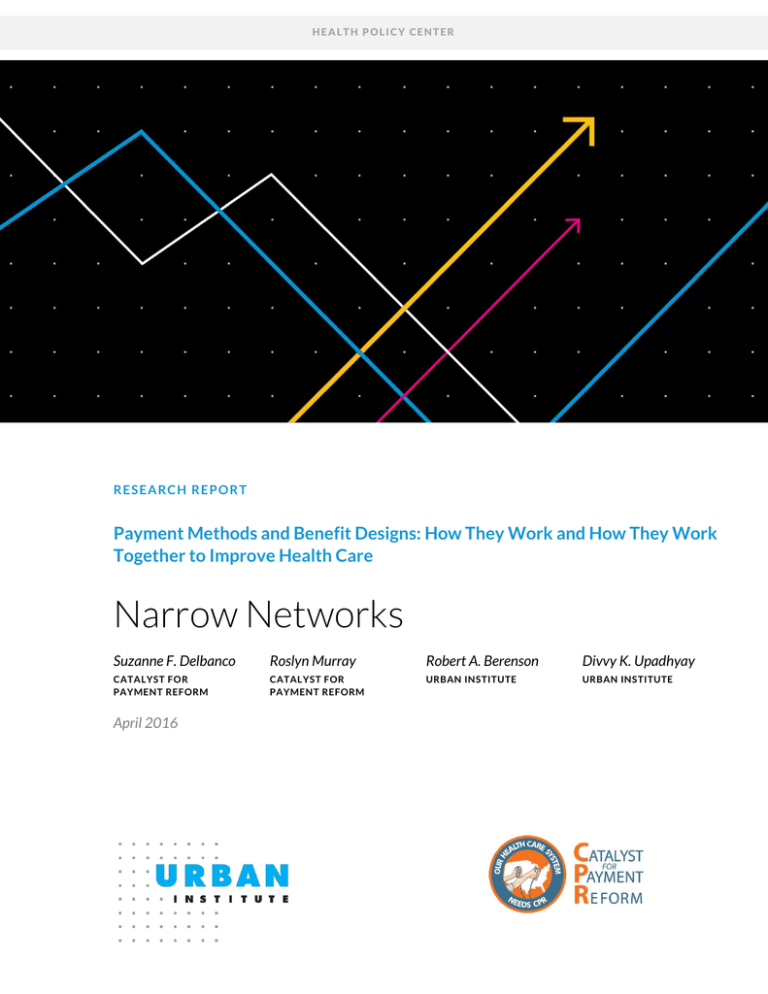Narrow Networks Payment Methods and Benefit Designs: Together to Improve Health Care
advertisement

HEALTH POLICY CENTER RESEA RC H RE PORT Payment Methods and Benefit Designs: How They Work and How They Work Together to Improve Health Care Narrow Networks Suzanne F. Delbanco Roslyn Murray Robert A. Berenson Divvy K. Upadhyay CATALYST FOR PAYMENT REFORM CATALYST FOR PAYMENT REFORM URBAN INSTITUTE URBAN INSTITUTE April 2016 ABOU T THE U RBA N INS TITU TE The nonprofit Urban Institute is dedicated to elevating the debate on social and economic policy. For nearly five decades, Urban scholars have conducted research and offered evidence-based solutions that improve lives and strengthen communities across a rapidly urbanizing world. Their objective research helps expand opportunities for all, reduce hardship among the most vulnerable, and strengthen the effectiveness of the public sector. Copyright © April 2016. Urban Institute. Permission is granted for reproduction of this file, with attribution to the Urban Institute. Cover image by Tim Meko. Contents Narrow Networks 1 Key Objectives of Narrow Networks 2 Strengths 3 Weaknesses 3 Design Choices to Mitigate Weaknesses 4 Network Adequacy 4 Availability of Quality Information 4 Selecting Providers 5 Appeals Process 5 Legal Environment 5 Compatibility with Other Benefit Designs and Payment Approaches 6 Focus of Performance Measurement 6 Potential Impact on Provider Prices and Price Increases 6 Acknowledgments 8 Statement of Independence 9 Payment reform promises to substitute value for volume. Yet, value- and volume-based approaches typically are implemented together. All payment methods have strengths and weaknesses, and how they affect the behavior of health care providers depends on their operational design features and, crucially, on how they interact with benefit design. Those seeking greater value for their health care dollar are also turning to innovation in benefit design, which also typically involves the implementation of more than one approach at a time—each with its own strengths, weaknesses, and effect on consumer health care behavior. Although payment and benefit design each has received significant attention independently, the intersection between the two has received little if any. The Urban Institute partnered with Catalyst for Payment Reform to explore how established and proposed payment methods and benefit design options work on their own and together. We also examined how payment and benefit design can be blended to improve health care delivery. This chapter is one of the seven benefit designs discussed in the report Benefit Designs: How They Work. All reports and chapters can be found on our project page: Payment Methods and Benefit Designs: How They Work and How They Work Together to Improve Health Care. Narrow Networks Narrow networks are created using cost and quality criteria to select health care providers from a broader provider network, then establishing strong incentives for consumers to seek care from just that set of providers. Consumers face very high cost-sharing and the risk of balance billing, or in some cases denial of insurance coverage, if they receive care from a provider outside the narrow network. Therefore, consumers are essentially limited to seeking care from a defined group of health care providers. Narrow networks can be an elective product that consumers choose at the time of enrollment in a health plan—a familiar example is the health maintenance organization (HMO) from the ‘90s. Today, the exchanges offer either broad or narrow network products. A narrow network product could, for example, place providers in an accountable care organization (ACO) in-network and those providers not in the ACO out-of-network. Narrow networks are made up of a subsection of the providers in a geographic market; those in the network are “in-network” for all of the services they provide. Therefore, these networks are not organized like centers of excellence around individual service lines. As a result, quality for particular services may be uneven across providers in the narrow network. While narrow networks impose greater restrictions on a consumer’s choice of health care providers, consumers generally enroll in them to take advantage of lower premiums. Although these networks’ main objective is to lower costs for consumers, some implementers are creating networks to achieve higher value, using quality metrics to design the network. This can deflect the criticism that narrow networks focus solely on reducing costs. Narrow networks are not equally effective in all markets. They may be less able to lower costs in markets lacking provider competition, in which a dominant provider system must be included to ensure adequate access. Furthermore, a dominant provider group that wants to protect its high patient volume will use its leverage either to stop the effort by refusing to participate in the network or to demand an “in-network” designation while maintaining their higher rates. If the dominant provider commands higher-than-competitive prices and is in-network, the potential savings of a narrow network may not be realized. Key Objectives of Narrow Networks The major objective of narrow networks is to steer patients toward a group of providers that offer care at a reasonable cost, while not compromising on quality. With consumers and purchasers concerned about rising premiums, narrow networks can have great appeal in exchange for tighter restrictions on consumers’ choice of provider. Additionally, narrow networks can produce higher value than other products. Another major objective of narrow networks is that, in reasonably competitive markets, they can provide payers with additional leverage in price negotiations with providers. When patients are steered toward a specific set of providers, providers that are not in-network lose patient volumes. To maintain those volumes, they may be willing to negotiate with health plans for lower prices so that they can be included. 2 NARROW NETWORKS Strengths Narrow networks channel consumers to a more limited set of providers than is the norm in the market. This approach may increase the likelihood that patients will receive high-value care. Narrow networks can alleviate the concerns of many consumers and employer-purchasers about rising premium costs, as participating consumers will pay lower premiums than they would with less restrictive provider networks. Narrow networks have the potential to save consumers money because consumers are essentially limited to seeking care from lower-cost, sometimes higher-quality providers. In competitive markets, narrow networks can help curb providers’ negotiating leverage, since they will be concerned about losing patient volume if they are not designated in-network. Payers, therefore, can gain stronger negotiating leverage, which may enable them to negotiate lower rates than for products with broader provider networks. Providers have a greater ability to manage and coordinate care for consumers in narrow networks, because the consumers have limited ability to receive care from out-of-network providers. Narrow networks may be less confusing than tiered networks, since they draw a clear line between which providers are in-network or out-of-network and thus, cost-sharing has fewer nuances. Weaknesses Narrow networks can be unattractive to consumers because they restrict their choice of health care providers. Many consumers prefer the freedom to choose and thus may decide not to enroll in a narrow network. For implementers, it may be difficult to introduce lower-cost narrow networks in uncompetitive markets. For example, a dominant provider has the leverage to derail the network if it is not included or to demand higher prices that provide no differentiation from pricing in the rest of the market. NARROW NETWORKS 3 Narrow networks may not actually produce greater cost savings because of selection bias. Generally, younger, healthier populations are more willing to accept restricted provider access for lower premiums. And, because narrow networks are cheaper and may have less generous benefits, they may be unattractive to those who could most benefit from higher-value care. A specific provider with highly specialized expertise in a certain service or procedure may not be in-network, meaning no coverage for the consumer who seeks care from that provider. While most payers may allow for exceptions and undergo ad hoc negotiations with out-ofnetwork providers in specific circumstances, some may not. Many believe the process of designating providers in-network is often focused only on transaction prices and disregards the quality of care. When a member of a care team is not included in the network, for example, an anesthesiologist, the patient can encounter surprise billing that charges out-of-network rates for that provider, even though the surgeon and other providers involved in the care were in-network. Design Choices to Mitigate Weaknesses Network Adequacy When designing a narrow network, it is important to have an adequate number of providers in the network to ensure sufficient access for patients. Without an adequate network—for example in smaller or uncompetitive markets—consumers could face barriers to care if the panel of providers were too small. Smaller or uncompetitive networks could also lack expertise in particular specialties. Availability of Quality Information While consumers choose narrow networks for their lower costs, quality across the providers in the network could be uneven. Therefore, information about the quality of the providers in the network can help consumers identify which have better outcomes or expertise in particular procedures or services. 4 NARROW NETWORKS Selecting Providers Providers can be designated as in-network based on cost, quality, or both; however, most networks designate providers based on both cost and quality, or based on value. Those that designate solely on efficiency or cost have received significant criticism. Where the designer of the narrow network sets the required level of “value” will also affect how large the network is, and how beneficial this strategy will be in reducing health care expenditures and improving the quality of care. Appeals Process For patients with highly specialized needs, a speedy appeals mechanism is needed to allow them to seek care from an out-of-network specialist. If the payer does not grant the appeal, patients will either receive less-than-optimal care (potentially leading to higher spending) or pay the full cost of any care from an out-of-network provider. This financial barrier may mean that patients do not get the care they need for their condition. Legal Environment Local laws and regulations can affect the potential success of narrow networks. Laws and statesponsored educational resources about health care prices and quality can support the development of narrow networks. State laws on “most favored nation” contracting clauses may help the health plan implementing a narrow network by forcing providers to give that health plan the lowest prices and obligating them to charge other payers more. But this can also prevent other health plans from entering local markets, stifling competition. Further, “any willing provider” regulations for health care providers require health plans to accept any qualified provider willing to agree to the plan’s terms and conditions. Where these regulations limit a carrier’s ability to develop selective, high-value provider networks, a plan’s ability to manage costs in a consolidated market may be limited. NARROW NETWORKS 5 Compatibility with Other Benefit Designs and Payment Approaches When narrow networks were originally used with HMO products, the model required preauthorization—the patient’s primary care physician acted as a “gatekeeper,” referring the patient to other providers for specialty services. This pairing is used regularly today. Narrow networks often use quality and cost criteria to distinguish in-network providers from outof-network providers. Therefore, payment methods that incorporate cost and quality performance measures may complement narrow networks. For example, a shared savings or shared risk payment arrangement—like those used to support many ACO models—would tie provider payment amounts to the ability to stay within budget while meeting quality standards. Payers could use the same measures that determine which providers are in-network to judge eligibility to share in any savings. Additionally, consumers could be incentivized to receive their care from providers under risk (in shared risk or capitation arrangements), and not go out-of-network for care. Focus of Performance Measurement In the past, there have been concerns that if providers are paid on a capitated basis in a narrownetwork-like product, they may stint on care provided to patients. While providers are generally designated based on cost and quality performance, the incentives under capitated payments encourage prudent spending, as providers are paid a lump sum for all of the care they deliver. Therefore, it would be important to monitor the quality of care using measures that assess whether patients are getting recommended care, specifically secondary preventive services, and assess patients’ experience of care. While we currently don’t have adequate measures to assess the appropriateness of referrals, they would be an important addition to evaluating the effectiveness of narrow networks. Potential Impact on Provider Prices and Price Increases A narrow network in a particular market has the potential to generate competition across providers and provider groups and bring prices down as a result. A narrow network may attract consumers because of the low premiums associated with enrollment as well as the designation of high-value providers participating in the network. Other providers or provider groups may lose patient volume from the new 6 NARROW NETWORKS arrangement. To avoid the loss of patient volumes, providers may be willing to give payers favorable prices. However, in uncompetitive markets, dominant providers may have the negotiating leverage with the payer. Large providers, especially, may know the payer will not meet network adequacy requirements without them. NARROW NETWORKS 7 Acknowledgments This report was funded by the Robert Wood Johnson Foundation. We are grateful to them and to all our funders, who make it possible for Urban to advance its mission. The views expressed are those of the authors and should not be attributed to the Urban Institute, its trustees, or its funders. Funders do not determine research findings or the insights and recommendations of Urban experts. Further information on the Urban Institute’s funding principles is available at www.urban.org/support. A technical expert panel advised the project team and reviewed the reports at different stages. 8 ACKNOWLEDGMENTS STATEMENT OF INDEPENDENCE The Urban Institute strives to meet the highest standards of integrity and quality in its research and analyses and in the evidence-based policy recommendations offered by its researchers and experts. We believe that operating consistent with the values of independence, rigor, and transparency is essential to maintaining those standards. As an organization, the Urban Institute does not take positions on issues, but it does empower and support its experts in sharing their own evidence-based views and policy recommendations that have been shaped by scholarship. Funders do not determine our research findings or the insights and recommendations of our experts. Urban scholars and experts are expected to be objective and follow the evidence wherever it may lead. 2100 M Street NW Washington, DC 20037 www.urban.org




